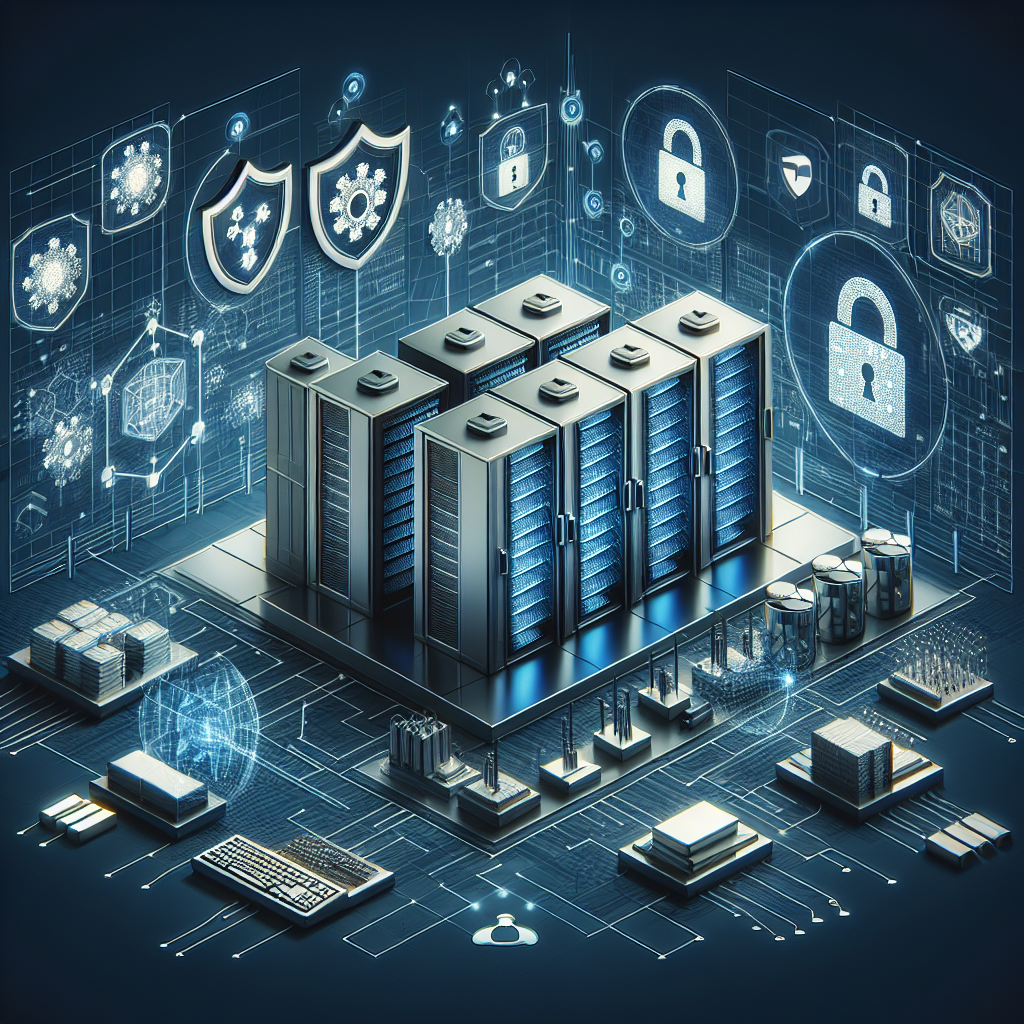Your cart is currently empty!
Tag: Strategy

Data Center Security Systems: A Critical Component of a Comprehensive Cybersecurity Strategy
As businesses and organizations increasingly rely on digital data and technology to operate, the need for robust cybersecurity measures has never been greater. One critical component of a comprehensive cybersecurity strategy is data center security systems. Data centers are the nerve centers of an organization’s IT infrastructure, housing the servers, storage devices, and networking equipment that store and process sensitive information. As such, they are prime targets for cyberattacks, making it essential to implement stringent security measures to protect against potential threats.Data center security systems encompass a range of technologies and protocols designed to safeguard the physical and digital assets housed within these facilities. These systems typically include access control measures such as biometric authentication, keycard systems, and surveillance cameras to monitor and control entry into the data center. Additionally, advanced encryption techniques and firewalls are used to secure the data stored on servers and prevent unauthorized access.
One of the key aspects of data center security is the concept of defense in depth, which involves implementing multiple layers of security to protect against different types of threats. This approach ensures that even if one layer is breached, there are additional measures in place to prevent further intrusion. For example, a data center may have perimeter security measures such as fences and security guards, as well as internal security controls like intrusion detection systems and data encryption.
In addition to physical security measures, data center security systems also include monitoring and incident response protocols to detect and mitigate potential threats in real-time. Security teams are tasked with monitoring network traffic, analyzing security logs, and responding to incidents promptly to minimize the impact of a breach. Regular security audits and penetration testing are also essential to identify vulnerabilities and strengthen the overall security posture of the data center.
As cyber threats continue to evolve and become more sophisticated, it is crucial for organizations to invest in robust data center security systems to protect their valuable data and assets. A comprehensive cybersecurity strategy that includes data center security measures can help mitigate the risks of data breaches, financial losses, and reputational damage associated with cyberattacks. By implementing the right security controls and protocols, organizations can ensure the confidentiality, integrity, and availability of their data, ultimately safeguarding their operations and reputation in an increasingly digital world.

The Essential Guide to Implementing a Successful Data Center Reactive Maintenance Strategy
In today’s digital age, data centers are the backbone of any organization’s operations. They house critical IT infrastructure and store vast amounts of data, making them essential for business continuity. However, data centers are also prone to equipment failures and downtime, which can have a significant impact on business operations and revenue.To mitigate the risk of downtime, many organizations implement a proactive maintenance strategy to ensure their data center equipment is running efficiently. However, proactive maintenance alone may not be enough to prevent unexpected failures. This is where reactive maintenance comes into play.
Reactive maintenance, also known as corrective maintenance, involves responding to equipment failures as they occur. While this approach may seem less ideal than proactive maintenance, it is still an essential component of a comprehensive maintenance strategy. In fact, a successful data center maintenance strategy should incorporate both proactive and reactive maintenance to ensure optimal performance and uptime.
Here are some essential tips for implementing a successful data center reactive maintenance strategy:
1. Establish a clear process for reporting and tracking equipment failures: It is crucial to have a system in place for employees to report equipment failures promptly. This will help the maintenance team prioritize and address issues in a timely manner.
2. Develop a comprehensive maintenance schedule: While proactive maintenance helps prevent equipment failures, it is still essential to have a schedule for reactive maintenance tasks. Regularly inspecting and servicing equipment can help identify potential issues before they escalate into major failures.
3. Invest in monitoring tools: Monitoring tools can help track the performance of data center equipment in real-time, allowing maintenance teams to identify potential issues before they cause downtime.
4. Train your maintenance team: Proper training is essential for a successful reactive maintenance strategy. Ensure your maintenance team is well-equipped to handle equipment failures efficiently and effectively.
5. Prioritize critical equipment: Not all equipment failures are created equal. Identify critical equipment that can cause significant downtime if it fails and prioritize maintenance tasks accordingly.
6. Document all maintenance tasks: Keeping detailed records of all maintenance tasks can help identify trends and patterns in equipment failures, enabling proactive measures to prevent future issues.
In conclusion, implementing a successful data center reactive maintenance strategy is essential for ensuring optimal performance and uptime. By incorporating proactive and reactive maintenance approaches, organizations can minimize downtime and maximize the efficiency of their data center operations. By following these essential tips, organizations can effectively manage equipment failures and maintain a reliable data center infrastructure.

How to Develop a Comprehensive Data Center Maintenance Strategy: Steps for Success
A data center is the heart of any organization’s IT infrastructure, housing critical servers, networking equipment, and storage devices that are essential for the smooth functioning of business operations. To ensure the optimal performance and longevity of these assets, it is vital to have a comprehensive data center maintenance strategy in place. A well-defined maintenance plan helps in preventing downtime, reducing operational costs, and extending the lifespan of equipment. In this article, we will discuss the steps for developing a successful data center maintenance strategy.Step 1: Perform a comprehensive assessment
The first step in developing a data center maintenance strategy is to conduct a thorough assessment of the existing infrastructure. This includes evaluating the condition of servers, storage devices, cooling systems, power distribution units, and other critical components. Identify any potential vulnerabilities or areas that require immediate attention. This assessment will help in determining the scope and frequency of maintenance activities.
Step 2: Define maintenance goals and objectives
Once the assessment is complete, define the maintenance goals and objectives for your data center. These goals should align with the overall business objectives and focus on improving reliability, efficiency, and performance. Consider factors such as uptime requirements, compliance with industry standards, and cost-effective maintenance practices.
Step 3: Develop a maintenance schedule
Based on the assessment and defined goals, develop a maintenance schedule that outlines the frequency and type of maintenance activities to be performed. This schedule should include preventive maintenance tasks, such as regular equipment inspections, firmware updates, and cleaning of hardware components. It should also include reactive maintenance tasks, such as troubleshooting and resolving issues as they arise.
Step 4: Implement proactive monitoring and alerting
To effectively manage and monitor the health of your data center equipment, implement proactive monitoring and alerting systems. These systems can help in detecting potential issues before they escalate into major problems, allowing for timely interventions. Set up alerts for critical events, such as temperature fluctuations, power outages, or hardware failures, and establish protocols for responding to these alerts.
Step 5: Establish a vendor support and maintenance plan
In addition to in-house maintenance activities, it is important to have a vendor support and maintenance plan in place for critical equipment. This plan should include details on warranty coverage, service level agreements, and procedures for accessing vendor support. Establish a relationship with trusted vendors and ensure that they are readily available to provide assistance when needed.
Step 6: Document and track maintenance activities
Maintaining detailed records of all maintenance activities is essential for tracking the performance of your data center infrastructure. Document each maintenance task, including the date, time, and personnel involved, as well as any issues encountered and resolutions applied. Use this information to identify trends, track equipment performance, and make informed decisions about future maintenance activities.
In conclusion, developing a comprehensive data center maintenance strategy is essential for ensuring the reliability and efficiency of your IT infrastructure. By following these steps and implementing best practices in maintenance management, you can minimize downtime, reduce operational costs, and maximize the lifespan of your equipment. Prioritize maintenance activities, establish proactive monitoring systems, and collaborate with trusted vendors to keep your data center running smoothly.

Key Benefits of Implementing a DCIM Strategy in Your Data Center
In today’s digital age, data centers play a crucial role in supporting the operations of businesses of all sizes. As the demand for digital services continues to grow, data centers are becoming increasingly complex and challenging to manage. This is where Data Center Infrastructure Management (DCIM) comes into play.DCIM is a comprehensive software solution that helps data center managers monitor, manage, and optimize their data center infrastructure. By implementing a DCIM strategy, organizations can benefit in numerous ways:
1. Improved Efficiency: One of the key benefits of implementing a DCIM strategy is improved efficiency. DCIM software provides real-time visibility into the performance of data center infrastructure, allowing managers to identify and address inefficiencies quickly. This can result in reduced energy consumption, lower operating costs, and improved overall performance.
2. Increased Uptime: Downtime can be costly for businesses, leading to lost revenue and damaged reputation. DCIM software helps data center managers proactively monitor and manage their infrastructure to prevent downtime. By identifying potential issues before they escalate, organizations can ensure maximum uptime for their critical systems.
3. Enhanced Capacity Planning: DCIM software provides valuable insights into the capacity of data center infrastructure, allowing managers to plan for future growth and expansion. By accurately forecasting capacity requirements, organizations can avoid over-provisioning or under-provisioning their infrastructure, saving time and money in the long run.
4. Compliance and Security: Data centers are subject to strict regulatory requirements and security standards. DCIM software helps organizations ensure compliance with these regulations by providing detailed reports and audits of infrastructure performance. Additionally, DCIM software can help identify and mitigate security risks, protecting sensitive data from potential breaches.
5. Simplified Management: Managing a data center can be a complex and time-consuming task. DCIM software streamlines the management process by providing a centralized platform for monitoring and controlling all aspects of the infrastructure. This can help data center managers save time and resources, allowing them to focus on strategic initiatives.
In conclusion, implementing a DCIM strategy in your data center can provide numerous benefits, including improved efficiency, increased uptime, enhanced capacity planning, compliance and security, and simplified management. By investing in DCIM software, organizations can optimize their data center operations and position themselves for future growth and success.

How to Develop an Effective Data Center Disaster Recovery Strategy
Data centers are the heart of any organization’s IT infrastructure, housing critical data and applications that are vital for business operations. However, disasters can strike at any time, posing a threat to this valuable information. That’s why it is crucial for organizations to have a robust disaster recovery strategy in place to protect their data and ensure business continuity.Developing an effective data center disaster recovery strategy involves a combination of planning, technology, and processes. Here are some key steps to help organizations create a solid disaster recovery plan:
1. Risk assessment: The first step in developing a disaster recovery strategy is to conduct a thorough risk assessment. This involves identifying potential risks and vulnerabilities that could impact the data center, such as natural disasters, cyber attacks, power outages, and hardware failures. By understanding the potential threats, organizations can better prepare for them and develop appropriate mitigation strategies.
2. Define recovery objectives: Once the risks have been identified, organizations need to establish clear recovery objectives. This involves determining the maximum allowable downtime for critical systems and applications, as well as the acceptable level of data loss. These recovery objectives will help guide the development of the disaster recovery plan and ensure that the organization can quickly recover from a disaster.
3. Backup and recovery solutions: One of the key components of a disaster recovery strategy is implementing reliable backup and recovery solutions. This includes regularly backing up critical data and applications to ensure that they can be quickly restored in the event of a disaster. Organizations should consider using a combination of onsite and offsite backups to minimize the risk of data loss.
4. Test and update the plan: A disaster recovery plan is only effective if it is regularly tested and updated. Organizations should conduct regular drills and simulations to ensure that the plan works as intended and that all stakeholders are familiar with their roles and responsibilities. Additionally, the plan should be reviewed and updated regularly to account for changes in technology, infrastructure, and business requirements.
5. Monitor and evaluate: Finally, organizations should continuously monitor and evaluate their disaster recovery strategy to identify potential weaknesses and areas for improvement. By regularly reviewing the plan and conducting post-disaster assessments, organizations can ensure that their data center is well-protected and that they are prepared to respond effectively to any unforeseen events.
In conclusion, developing an effective data center disaster recovery strategy is essential for protecting critical data and ensuring business continuity. By following these key steps, organizations can create a robust plan that will help them recover quickly from any disaster and minimize the impact on their operations. Investing in a solid disaster recovery strategy is a smart investment that can help organizations safeguard their valuable data and maintain the trust of their customers and stakeholders.

Predictive Maintenance: A Must-Have Strategy for Data Center Efficiency
In today’s digital age, data centers play a critical role in storing, processing, and managing vast amounts of data. With the increasing importance of data centers, ensuring their efficiency and reliability has become a top priority for businesses. One key strategy that organizations are turning to is predictive maintenance.Predictive maintenance is a proactive approach to maintenance that uses data and analytics to predict when equipment is likely to fail. By analyzing historical data, trends, and patterns, organizations can identify potential issues before they occur and take corrective action to prevent downtime and costly repairs.
In the context of data centers, predictive maintenance can help organizations optimize the performance of their equipment, improve energy efficiency, and extend the lifespan of their assets. By monitoring key metrics such as temperature, humidity, power consumption, and equipment usage, organizations can identify potential problems early on and address them before they escalate.
One of the key benefits of predictive maintenance is its ability to reduce downtime. By predicting when equipment is likely to fail, organizations can schedule maintenance activities during off-peak hours or when the impact on operations is minimal. This can help minimize disruptions to business operations and ensure that critical services remain up and running.
Another advantage of predictive maintenance is its ability to improve energy efficiency. By monitoring equipment performance and identifying inefficiencies, organizations can make data-driven decisions to optimize energy usage and reduce costs. This can lead to significant savings in energy bills and contribute to a more sustainable and environmentally friendly data center operation.
In addition, predictive maintenance can help organizations extend the lifespan of their equipment. By identifying and addressing issues early on, organizations can prevent premature equipment failures and costly replacements. This can help organizations maximize their return on investment and ensure that their data center infrastructure remains reliable and efficient for years to come.
Overall, predictive maintenance is a must-have strategy for data center efficiency. By leveraging data and analytics to anticipate and prevent equipment failures, organizations can optimize performance, reduce downtime, improve energy efficiency, and extend the lifespan of their assets. With the increasing complexity and importance of data centers, predictive maintenance is essential for organizations looking to stay competitive and ensure the reliability of their critical infrastructure.

Challenges and Solutions in Implementing a DCIM Strategy for Your Data Center
Data Center Infrastructure Management (DCIM) is a software solution that helps organizations efficiently manage their data center operations. Implementing a DCIM strategy can bring numerous benefits, such as improved energy efficiency, reduced downtime, and better resource utilization. However, there are also challenges that organizations may face when implementing a DCIM strategy. In this article, we will discuss some of these challenges and provide solutions to overcome them.Challenges in Implementing a DCIM Strategy:
1. Lack of Data: One of the biggest challenges in implementing a DCIM strategy is the lack of accurate and up-to-date data about the data center infrastructure. Without this data, it is difficult to make informed decisions and optimize data center operations.
2. Integration with Existing Systems: Another challenge is integrating DCIM software with existing systems and processes. Many organizations already have various monitoring and management tools in place, and integrating DCIM software with these systems can be complex and time-consuming.
3. Resistance to Change: Implementing a DCIM strategy often requires changes in processes and workflows, which can be met with resistance from employees who are used to working in a certain way.
4. Cost: Implementing a DCIM strategy can be costly, especially for small and medium-sized organizations with limited budgets. The initial investment in software and hardware, as well as ongoing maintenance and training costs, can be significant.
5. Complexity: DCIM software is complex and requires specialized knowledge and skills to implement and manage effectively. This can be a challenge for organizations that do not have dedicated IT staff with expertise in data center management.
Solutions to Overcome Challenges in Implementing a DCIM Strategy:
1. Conduct a Data Audit: Before implementing a DCIM strategy, organizations should conduct a thorough data audit to ensure that they have accurate and up-to-date information about their data center infrastructure. This will help identify any gaps in data and ensure that decisions are based on reliable information.
2. Plan for Integration: Organizations should carefully plan the integration of DCIM software with existing systems and processes. This may involve working closely with vendors and IT teams to ensure a smooth transition and minimize disruption to operations.
3. Communicate and Train: To overcome resistance to change, organizations should communicate the benefits of implementing a DCIM strategy to employees and provide training to help them understand how the new system will improve data center operations.
4. Consider Total Cost of Ownership: When evaluating the cost of implementing a DCIM strategy, organizations should consider the total cost of ownership, including upfront costs, ongoing maintenance, and training expenses. They should also consider the potential cost savings and benefits of improved data center management.
5. Seek Expert Help: Organizations that lack the expertise and resources to implement a DCIM strategy internally should consider seeking help from external consultants or service providers with experience in data center management.
In conclusion, implementing a DCIM strategy for your data center can bring numerous benefits, but it also comes with challenges that need to be addressed. By conducting a data audit, planning for integration, communicating and training employees, considering total cost of ownership, and seeking expert help, organizations can overcome these challenges and successfully implement a DCIM strategy to improve their data center operations.

Preparing for the Worst: How to Create a Comprehensive Data Center Disaster Recovery Strategy
In today’s digital age, data centers play a crucial role in storing and managing vast amounts of information for businesses and organizations. However, with the increasing reliance on technology, the risk of data center disasters has also grown significantly. From natural disasters like hurricanes and earthquakes to cyber-attacks and human errors, there are numerous threats that can disrupt or destroy a data center and the valuable data it houses.To mitigate the impact of such disasters, it is essential for businesses to have a comprehensive data center disaster recovery strategy in place. This strategy outlines the steps and procedures that need to be taken to ensure the quick and efficient recovery of data and operations in the event of a disaster. Here are some key steps to creating a robust disaster recovery strategy for your data center:
1. Conduct a Risk Assessment: Start by identifying the potential risks and threats that could impact your data center. This could include natural disasters, cyber-attacks, power outages, equipment failures, and human errors. By understanding the risks, you can prioritize your resources and efforts towards mitigating the most critical threats.
2. Define Recovery Objectives: Determine the recovery objectives for your data center, including the maximum allowable downtime, recovery point objectives (RPO), and recovery time objectives (RTO). This will help you establish clear goals for restoring data and operations in the event of a disaster.
3. Develop a Data Backup and Recovery Plan: Implement a robust data backup and recovery plan that includes regular backups of critical data, offsite storage of backups, and automated backup processes. Ensure that your backups are tested regularly to verify their integrity and reliability.
4. Implement Redundant Systems and Infrastructure: To minimize downtime and ensure continuity of operations, consider implementing redundant systems and infrastructure in your data center. This could include redundant power supplies, network connections, storage systems, and servers.
5. Create a Communication Plan: Establish a communication plan that outlines how you will notify and update key stakeholders, employees, and customers in the event of a data center disaster. Ensure that contact information is up to date and that communication channels are readily available.
6. Conduct Regular Testing and Exercises: Regularly test and exercise your data center disaster recovery plan to identify any gaps or weaknesses. This could involve simulated disaster scenarios, tabletop exercises, and full-scale drills to ensure that your team is prepared to respond effectively in a real-life emergency.
7. Document and Update Your Plan: Document your data center disaster recovery plan in detail, including procedures, contact information, and recovery steps. Regularly review and update your plan to reflect changes in technology, infrastructure, and risks.
In conclusion, creating a comprehensive data center disaster recovery strategy is essential for protecting your business from the potential impact of disasters. By following these key steps and best practices, you can ensure that your data center is prepared to respond quickly and effectively in the face of adversity. Remember, it’s not a matter of if a disaster will strike, but when – so be proactive and prepared for the worst.

Best Practices for Implementing an Effective Data Center Monitoring Strategy
In today’s digital age, data centers play a crucial role in storing, processing, and transmitting vast amounts of data. As such, it is essential for organizations to implement an effective data center monitoring strategy to ensure the smooth operation and optimal performance of their data centers. In this article, we will discuss some best practices for implementing an effective data center monitoring strategy.1. Define clear objectives and goals: Before implementing a data center monitoring strategy, it is important to define clear objectives and goals. Determine what key performance indicators (KPIs) you want to monitor, such as server uptime, network bandwidth usage, and power consumption. Establishing clear objectives will help you focus on what is most important for your data center’s performance and efficiency.
2. Choose the right monitoring tools: There are a variety of monitoring tools available in the market, ranging from basic server monitoring tools to comprehensive data center infrastructure management (DCIM) solutions. It is essential to choose the right monitoring tools that align with your objectives and goals. Consider factors such as scalability, ease of use, and integration capabilities when selecting monitoring tools for your data center.
3. Monitor all critical components: A comprehensive data center monitoring strategy should cover all critical components of your data center, including servers, storage devices, networking equipment, and environmental factors like temperature and humidity. Monitoring all critical components will give you a holistic view of your data center’s performance and help you identify and address potential issues before they escalate.
4. Implement real-time monitoring: Real-time monitoring is essential for proactive problem detection and resolution. By monitoring key metrics in real-time, you can quickly identify performance bottlenecks, anomalies, and potential failures, allowing you to take immediate action to mitigate risks and ensure uninterrupted operations.
5. Establish alerting and escalation processes: In addition to real-time monitoring, it is important to establish alerting and escalation processes to notify key stakeholders in case of critical events or issues. Define clear thresholds for key performance metrics and configure alerts to notify relevant personnel via email, SMS, or other communication channels. Establishing clear escalation processes will ensure timely response and resolution of issues to minimize downtime and service disruptions.
6. Regularly review and optimize monitoring strategy: Data center environments are dynamic and constantly evolving, so it is important to regularly review and optimize your monitoring strategy to ensure its effectiveness. Conduct regular audits of your monitoring tools and processes, and make adjustments as needed to address changing requirements and technologies.
In conclusion, implementing an effective data center monitoring strategy is essential for maintaining the performance, reliability, and efficiency of your data center. By following these best practices, organizations can proactively monitor their data center infrastructure, detect potential issues early, and ensure seamless operations to meet the demands of today’s digital economy.

A Winning Strategy: How to Optimize Data Center Performance for Improved Results
In today’s fast-paced digital world, data centers play a crucial role in ensuring businesses operate smoothly and efficiently. These centralized facilities house computer systems and storage devices that store, process, and distribute large amounts of data. However, as the demand for data continues to grow, it’s essential for organizations to optimize their data center performance to achieve improved results.There are several strategies that businesses can implement to enhance the efficiency and effectiveness of their data centers. By following these tips, organizations can maximize their data center performance and ultimately improve their overall operations.
One key strategy for optimizing data center performance is to regularly assess and monitor the facility’s energy consumption. Data centers are known to be significant energy consumers, so it’s essential to ensure that energy is being used efficiently. By monitoring energy usage and implementing energy-saving measures, businesses can reduce costs and improve the overall performance of their data center.
Another important strategy is to implement virtualization technology. Virtualization allows organizations to run multiple virtual machines on a single physical server, which can help improve performance and reduce the need for additional hardware. By utilizing virtualization technology, businesses can increase efficiency, flexibility, and scalability within their data centers.
Additionally, businesses can optimize their data center performance by implementing proper cooling and airflow management. Data centers generate a significant amount of heat, so it’s crucial to ensure that cooling systems are in place to maintain optimal temperatures. By implementing efficient cooling systems and airflow management techniques, organizations can prevent overheating and improve the overall performance of their data center.
Another key strategy for optimizing data center performance is to regularly update and maintain hardware and software systems. Outdated systems can lead to inefficiencies and performance issues, so it’s essential to keep hardware and software up to date to ensure optimal performance. By regularly updating systems and performing maintenance tasks, businesses can improve the reliability and performance of their data center.
In conclusion, optimizing data center performance is essential for businesses looking to achieve improved results. By implementing strategies such as monitoring energy consumption, utilizing virtualization technology, managing cooling and airflow, and maintaining hardware and software systems, organizations can maximize the efficiency and effectiveness of their data centers. By following these tips, businesses can ensure that their data centers operate at peak performance, ultimately leading to improved results and a competitive edge in today’s digital landscape.
